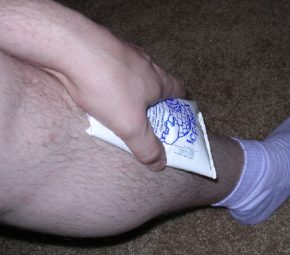This post may contain affiliate links to products or services which, if you purchase, may result in my earning commissions at no additional cost to you.
Written by Dr. Beau B Hightower
MS, DC, CSCS, CES
Knee pain and hip pain are painfully common ailments in society as a whole, but have been known to cost MMA fighters opportunities in the ring and sideline a whole myriad of athletes who rely on distance running for condition.
A common, yet misunderstand cause of both hip and knee pain is pain related to the Iliotibial Band. The Iliotibial or IT Band can manifest pain and disability in several different ways, but the most common way that this condition presents is with sharp pain on the outside of the knee that is made worse by running.
Another common symptom is severe lateral knee pain when moving from seated to standing position after a long period of sitting. Prolonged IT Band dysfunction can lead to debilitating range of motion loss in the knee as well as severe hip pain and occasionally numbness in the lateral lower leg and foot.
IT Band pain’s most common alias is the term runner’s knee, but this injury is far more prevalent, and under-diagnosed, in patients that don’t actually spend much time running.
The IT band is an area of thick connective tissue that begins at the side of your hip and ends just past the knee on the Tibia bone. The band is made of fascia, and as such exhibits properties that are different than muscle, the main property being that it is very difficult to stretch both histologically (on a cell level) and bio-mechanically.
The band also crosses over the top of the greater trochanteric bursa on the lateral hip, and thus can cause acute hip bursitis if the IT band is overactive.
Bursa, are sacs of fluid designed to cushion areas of bone from pressure and when they become inflamed, present with sharp, burning pain at the site of the bursa. Patients dealing with this type of hip pains are often x-ray imaged and told that they need a hip replacement, when a simple cortisone shot at the bursa and a foam roller home exercise program would typically suffice for injury resolution.
Check out these IT Band Straps and Foam Rollers
Fighters often experience IT Band dysfunction as a consequence of road work, which is the traditional runner’s knee presentation, and as a consequence of taking knees and kicks to the side of the thigh.
How do you know if you have IT band dysfunction?
There is an easy way to check, simply lay on a foam roller on the lateral part of your thigh. If you experience excruciating pain or discomfort, then there is a high probability that you are experiencing over-activity in your Iliotibial band.
Occasionally, patients will present to my office that have had their condition deteriorate to the point where they can’t bend their knee at all. These patients again are typically x-ray imaged by traditional medical providers, and told that they have arthritis, and that they are a candidate for cortisone shots, arthroscopic surgery, or the dreaded “lateral release” surgery.
Because the common peroneal nerve can travel underneath the distal IT band and its synergist muscles of the lateral hamstring, occasionally patients will present with burning pain in their lateral calf muscle, and/or numbness in their lateral calf and foot. Doctors will often assume that these symptoms are coming from the spine, and as such will order imaging of the lower back and possibly attempt cortisone shots at the disc in the lumbar spine.
If you press on the lateral side of your knee and the symptoms increase, you are likely dealing with a sensory peroneal neuropathy (specifically lateral dorsal cutaneous nerve).
Women tend to have a higher incidence of IT band symptoms do the their increased Q-angle of the hip. Also, if you are running for distance, you are likely to experience these symptoms due to the braking nature of distance running. Sprinters rarely suffer the same symptomotology due to the full extension of the knee and hip joints achieved during the running motion.
Making a habit of utilizing a foam roller on your IT bands, quadriceps, and groin muscles will significantly improve your thigh and knee pain, and will make your activities much more tolerable.
Most IT band rehabilitation programs will consist of the following:
- Stretching of the hip flexors and abdominals
- Strengthening of the gluteus medius (exercises like resisted side steps or monster walks)
- Inhibition of the IT band and quadriceps muscles by using the foam roller
- Inhibition of the calf muscles and lateral lower leg (peroneals) but use of the foam roller
- Strengthening of the tibial muscles by using Theraband resistance exercises
You can Find Therabands online for less than $15
Use of the foam roller prior to any lower body activity is a must for those suffering from IT band pain and dysfunction.
The following is an example of how to use the foam roller on your IT band and other thigh muscles!
http://www.youtube.com/watch?v=ClsjNw0iKFE
Stay in the game and keep on rolling!
Disclaimer: This article is for educational purposes only. If you have a medical condition, it is prudent that you seek medical evaluation by a properly qualified and licensed practitioner.
Dr. Beau Hightower is a former collegiate athlete and avid fight fan. He serves as the President of Elite Ortho-Therapy and Sports Medicine LLC, the premier sports injury resolution center in New Mexico. He serves on the Executive Board of Directors for Parker University and their Alumni Association and treats many elite level UFC fighters in his home practice.
Elite-OSM.com



